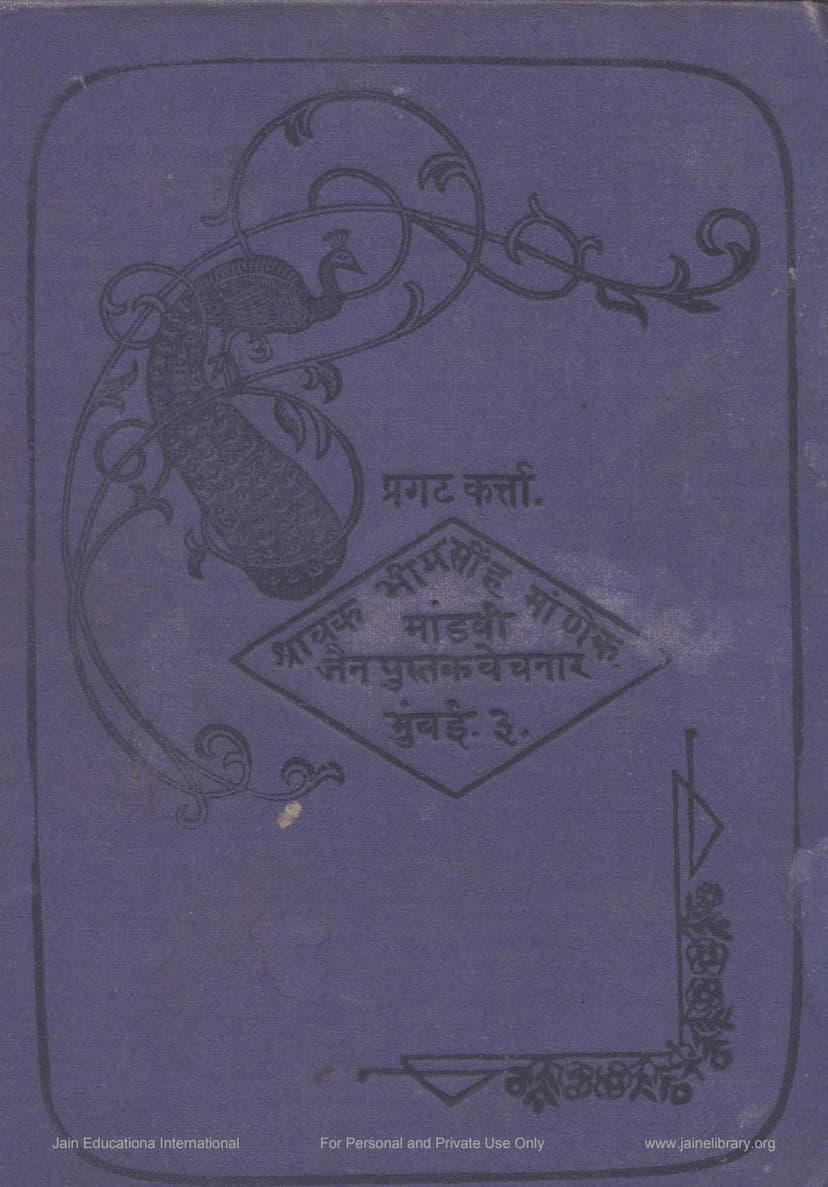Mahabal Malayasundarino Ras
Added to library: September 2, 2025

Summary
This summary is based on the provided text of "Mahabal Malayasundarino Ras" by Shravak Bhimsinh Manek. The text is a Gujarati Jain religious narrative, likely a "Ras," a devotional poetic composition.
Title: Shri Mahabal Malayasundarino Ras (The Story of Mahabal and Malayasundari) Author: Pandit Shri Kantivijayji (the poet) Publisher: Shravak Bhimsinh Manek Edition: Second edition, published in Samvat 1963 (1907 CE). Publisher's Location: Shri Mohammayi Pattan (likely a city in Gujarat, India) Printing Press: Shanti Sudhakar Press
Overall Theme: The "Ras" is a narrative focused on virtue, righteousness (dharma), and spiritual development. It appears to highlight the importance of knowledge (nan) and right conduct (charitra) as paths to liberation and happiness, as emphasized in Jain philosophy. The story likely revolves around the characters of Mahabal and Malayasundari and their spiritual journey, potentially involving trials, overcoming desires, and attaining a virtuous life.
Key Elements and Narrative Progression (based on the translated chapter titles and initial verses):
- Devotional Opening: The text begins with auspicious invocations to Jain Tirthankaras, particularly Lord Mahavir, and Goddess Saraswati, seeking divine blessings for the composition and its readers. This sets a devotional tone.
- Emphasis on Knowledge (Nan): Early verses (pages 5-6) strongly emphasize the importance of nan (knowledge) as the key to understanding reality, overcoming obstacles, and achieving inner peace. It is described as a guiding light and a means to cross the ocean of worldly existence. The story of Malayasundari finding happiness through contemplation of nan is hinted at.
- Narrative Structure: The story unfolds in a series of "Dhals" (chapters or sections), each likely presenting a part of the narrative and often sung in a specific meter.
- Character Introduction: The initial descriptions (pages 6-8) introduce the setting of Jambu-dwipa and a prosperous city named Chandravati, ruled by King Viradhaval. His queens, Champakamala and Kanakavati, are mentioned. The king is depicted as a just and benevolent ruler.
- The King's Distress: A significant portion of the narrative (pages 8-11) focuses on King Viradhaval's profound sorrow and inactivity. His queens and ministers attempt to understand and alleviate his distress, probing the cause of his deep melancholy.
- The Nature of Attachment and Desire: The narrative seems to explore the destructive nature of desires and attachments, as indicated by the king's state. The dialogue with his queens suggests introspection on the causes of suffering.
- The "Tumbi" Incident (Pages 11-17): A significant episode involves two merchants and a mysterious gourd (tumbi) that yields a precious liquid. This incident seems to illustrate themes of greed, deceit, and the consequences of unethical actions. The narrative likely highlights how cunning and falsehood lead to downfall, while integrity is rewarded.
- Supernatural Elements and Incidents: The text describes the intervention of deities, magical occurrences, and potentially demonic forces (like the "Rakshasa" on pages 17-31). The story of the king being afflicted by a demon and the subsequent efforts to cure him through various rituals and tantric practices are detailed. The son of the king, Kunar, plays a role in these events.
- The "Kumbh" or Pot Episode (Pages 33-37): This section describes a miraculous pot found in a mountain cave, which has a unique property of granting a son to those who are childless. This might be a key element in the story's progression.
- The Tale of the "Yogini" (Pages 23-28): This part of the narrative details the encounter with a Yogini who reveals a hidden secret about the king's lineage or a past event. Her story involves a deceptive pact and her tragic transformation.
- The King's Wife's Predicament (Pages 37-44): The narrative shifts to the queen's suffering and the king's deep grief over her apparent death due to poisoning. The efforts to revive her and the subsequent despair are described.
- The King's Journey and Encounter with a "Khechari" (Pages 17-23): The king's search for a cure or solution leads him to a deserted city and an encounter with a mysterious being named Khechari. This being narrates the story of the city's downfall and the king's own past actions.
- The Serpent's Transformation and the Role of the "Tumbi" (Pages 59-65): The narrative involves a serpent, a magical gourd, and a transformation. This episode likely illustrates the consequences of past deeds and the power of destiny.
- The King's Recovery and Devotion (Pages 65-70): The story culminates in the king's recovery, likely through divine intervention or spiritual practices, and his renewed devotion to Jain principles.
- The Story of Malayasundari's Virtues (Pages 70-78): The narrative likely describes Malayasundari's virtuous character, her devotion, and how she navigures challenges.
- The "Makardhwaj" Incident (Pages 70-78): This part of the story seems to involve a character named Makardhwaj, his encounters, and possibly his spiritual journey or the consequences of his actions.
- The "Swapnav" Incident (Pages 16-20): This section describes a dream-like experience that reveals the king's true nature or a hidden truth.
- The Story of the "Chor" (Thief) and the "Gourd" (Pages 13-17): This incident highlights deceit and its repercussions.
- The King's Resolution and the Importance of Righteousness: The overall narrative reinforces the Jain principles of karma, righteousness, and the pursuit of liberation through virtuous conduct and right faith.
Overall Message: The "Ras" serves as a moral and spiritual guide, likely teaching the readers about:
- The consequences of actions (karma).
- The importance of virtue, righteousness, and faith.
- The transient nature of worldly pleasures and possessions.
- The power of knowledge and spiritual discipline in overcoming suffering.
- The ultimate goal of liberation (moksha).
The text is a devotional work intended to inspire readers towards a virtuous life and adherence to Jain principles.